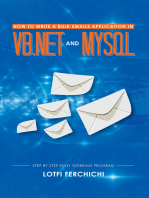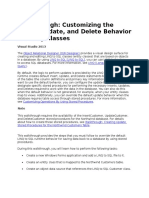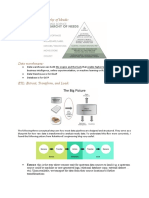LINQ - Tutorial LINQ To SQL - Part 1 (CodeGod - de Backup)
Uploaded by
Justin RobinsonLINQ - Tutorial LINQ To SQL - Part 1 (CodeGod - de Backup)
Uploaded by
Justin RobinsonHome Search Links Add Url Add article Members Namespaces .
NET Chat
Tutorial LINQ to SQL - Part 1 Section: Database serial submitted this resource Visit the profile here Rating: Not rated yet!
Introduction
This article is the first in series, to get closer with LINQ to SQL. Maybe you ask, what is the based language LINQ?
What is LINQ?
LINQ is the abbreviation for Language Integrated Query and it's developed by Microsoft. The goal of LINQ is to directly involve SQL, XLink and XQuery queries in a programming language like C# or VB.net. The advantage of LINQ is that the compiler can check the code for errors or to optimize it.
The syntax is similar to SQL like "select", "from" and "where". Ok, and is LINQ to SQL something special? - LINQ to SQL is a kind of O/R-Mapper, and how it works I will show you in this and the following articles.
What is LINQ to SQL (LtSQL)?
As I said Linq is an O/RM which allows you to model a relational database using classes. You can query your database with LtSQL, delete data and so on. LtSQL supports transactions, views and stored procedures. Now let's start with practice.
Modelling Databases with LtSQL
With the LtSQL-Designer you can easily create a representation of the northwind-database:
Figure 1 In the designer there are four classes designed (INHO the most used tables from northwind around the world?): Product, Category, Order and OrderDetail. Each property of a class represents a column in the table and an instance of a class represesents a row in the database. The arrows and lines are like UML and shows relationships. The right window shows stored procedures wich interacts with our database.
The DataContext, what is it?
If you finished modelling and mapping the database-representation and press "Save", Visual Studio creates classes that represent the database and our relationships. And a DataContext will be created for each LinqToSQL-File we add to our solution. The DataContext is the main object through wich we will communicate with our database. The properties of the DataContext class are the tables and stored procedures in the database we modelled/created. The model we created above, generates this NorthwindDataContext.
Figure 2 So, the database is modelled and our classes are created, and now? Let's show some code-examples for working with all these classes.
Get Products from the Database
The following code creates an instance of the northwind-datacontext through which we get access to the database. After that we use the new variant-datatype to create an IEnumerable products-instance in which all needed products are stored. We get the data with SQL-Like LINQ-Syntax where all Products have the Categoryname "Beverages". The "select product" statement adds the product to the collection.
NorthwindDataContext nwContext = new NorthwindDataContext(); var products = from product in nwContext where product.Category.CategoryName = "Beverages" select product;
Update a Product in the database
Like the first listing, we create a NorthwindDataContext and a product-instance. The product will be the one which has the Name "Toy 1". FEB APR http://w w w .codegod.de/WebAppCodeGod/Tutorial-LINQ-to-SQL---Part-1-AID466.a Go The statement "prod=>prod.ProductName == "Toy 1" " includes the new lambda-expression and means something like 7 captures 13 (example):
18 Apr 08 - 13 Apr 10
MAY Clo He
2008
2010
2011
product =
from product in nwContext.Products where product.ProductName = "Toy 1"
Then we change some details of the product and save the changes in the database.
NorthwindDataContext nwContext = new NorthwindDataContext(); Product product = nwContext.Products.Single( prod => prod.ProductName == "Toy 1"); product.UnitPrice = 100; product.UnitsInStock = 10; nwContext.SubmitChagnes();
Insert a new Category and new Products in the Database
In this sample we create a new category and two new products, for that we create a northwind-datacontext again. After that we add a new category and two new products. As you can see we give the products names, add them to the new category and write the category in the database. Based on our modelled relationships, the products are written correctly to the database, too.
NorthwindDataContext nwContext = new NorthwindDataContext(); Category category = new Category(); category.CategoryName = "Serial - Things"; Product product1 = new Product();
Product product2 = new Product(); product1.ProductName = "Thing 1"; product2.ProductName = "Thing2"; category.Products.Add(product1); category.Products.Add(product2); nwContext.Categories.Add(category); nwContext.SubmitChanges();
And now we just delete some products from the database the same way as before.
NorthwindDataContext nwContext = new NorthwindDataContext(); var products = from product in nwContext.Products where product.ProductName.Contains("Toy") select product; nwContext.Products.RemoveAll(products); nwContext.SubmitChanges();
You see, LINQ to SQL is an easy way to work with databases. I hope this introduction helps you to work with LtSQL. The next articles go deeper into some details, so stay tuned.
Reader-Comments:
Impressum | AGB | Datenschutzerklrung Top-Handy-Bundles | Anzeigen Web | Kostenlose Kleinanzeigen | Kleinanzeigen-Riese anzeigen-kostenlos.com | Singlebrse kostenlos | Suchmaschinenoptimierung | Plastikkarten Drucker | Firmen aus Bayern Website-Work | Fehlsichtigkeit | dotnet-forum | .NET BlogBook | Schufa | SEO | Place my ad here...
You might also like
- Attester Form - Smart Id: National Database and Registration Authority71% (7)Attester Form - Smart Id: National Database and Registration Authority1 page
- Using LINQ To SQL (Part 1) - ScottGu's BlogNo ratings yetUsing LINQ To SQL (Part 1) - ScottGu's Blog17 pages
- Video How To: Simple Object Model and Query (Visual Basic) (Linq To SQL)No ratings yetVideo How To: Simple Object Model and Query (Visual Basic) (Linq To SQL)4 pages
- Creating Client Data Applications - LinqNo ratings yetCreating Client Data Applications - Linq17 pages
- MySQL, LINQ and The ADO NET Entity Framework100% (10)MySQL, LINQ and The ADO NET Entity Framework32 pages
- How to Write a Bulk Emails Application in Vb.Net and Mysql: Step by Step Fully Working ProgramFrom EverandHow to Write a Bulk Emails Application in Vb.Net and Mysql: Step by Step Fully Working ProgramNo ratings yet
- Database Communication Using Web ServicesNo ratings yetDatabase Communication Using Web Services43 pages
- LINQ (Language Integrated Query) : From in SelectNo ratings yetLINQ (Language Integrated Query) : From in Select18 pages
- Mastering Node.js Web Development: Go on a comprehensive journey from the fundamentals to advanced web development with Node.jsFrom EverandMastering Node.js Web Development: Go on a comprehensive journey from the fundamentals to advanced web development with Node.jsNo ratings yet
- Customizing The Insert, Update, and Delete Behavior of Entity ClassesNo ratings yetCustomizing The Insert, Update, and Delete Behavior of Entity Classes8 pages
- 10 Tips To Improve Your LINQ To SQL Application PerformanceNo ratings yet10 Tips To Improve Your LINQ To SQL Application Performance7 pages
- Language Integrated Query (LINQ) : Israr AliNo ratings yetLanguage Integrated Query (LINQ) : Israr Ali24 pages
- Developing Web Applications Using Microsoft Visual Studio 2008No ratings yetDeveloping Web Applications Using Microsoft Visual Studio 200822 pages
- Information Management System Using LINQ OverNo ratings yetInformation Management System Using LINQ Over3 pages
- DATABASE From the conceptual model to the final application in Access, Visual Basic, Pascal, Html and Php: Inside, examples of applications created with Access, Visual Studio, Lazarus and WampFrom EverandDATABASE From the conceptual model to the final application in Access, Visual Basic, Pascal, Html and Php: Inside, examples of applications created with Access, Visual Studio, Lazarus and WampNo ratings yet
- Knight's Microsoft SQL Server 2012 Integration Services 24-Hour TrainerFrom EverandKnight's Microsoft SQL Server 2012 Integration Services 24-Hour TrainerNo ratings yet
- 3-Tier Architecture: Step by Step ExercisesNo ratings yet3-Tier Architecture: Step by Step Exercises71 pages
- Introduction To DBMS: Friday, March 14, 2008No ratings yetIntroduction To DBMS: Friday, March 14, 200819 pages
- ODP.NET Developer’s Guide: Oracle Database 10g Development with Visual Studio 2005 and the Oracle Data Provider for .NETFrom EverandODP.NET Developer’s Guide: Oracle Database 10g Development with Visual Studio 2005 and the Oracle Data Provider for .NETNo ratings yet
- Transaction Replication - Violation of PRIMARYNo ratings yetTransaction Replication - Violation of PRIMARY4 pages
- Commerce Bba CA Semester 6 2023 November Recent Trends in Information Technology 2019 PatternNo ratings yetCommerce Bba CA Semester 6 2023 November Recent Trends in Information Technology 2019 Pattern2 pages
- Oracle C++ Call Interface (Occi) : Shankar Iyer, Oracle IndiaNo ratings yetOracle C++ Call Interface (Occi) : Shankar Iyer, Oracle India93 pages
- Full Download (Ebook) Concepts of Database Management System by Shefali Naik ISBN 9789332526280, 9789332537231, 9332526281, 9332537232 PDF DOCX100% (1)Full Download (Ebook) Concepts of Database Management System by Shefali Naik ISBN 9789332526280, 9789332537231, 9332526281, 9332537232 PDF DOCX67 pages
- A Comprehensive Guide To Oracle Partitioning With SamplesNo ratings yetA Comprehensive Guide To Oracle Partitioning With Samples36 pages
- PL/SQL: By: Sonal Pandey M.E. CSE Dept. NITTTR ChandigarhNo ratings yetPL/SQL: By: Sonal Pandey M.E. CSE Dept. NITTTR Chandigarh42 pages
- kc4000 Week 8 Sub-Queries & Aggregation Part 1No ratings yetkc4000 Week 8 Sub-Queries & Aggregation Part 110 pages
- Miscellaneous Topics: Ilogic Technologies - Imp QueriesNo ratings yetMiscellaneous Topics: Ilogic Technologies - Imp Queries5 pages
- (eBook PDF) Modern Database Management 12th Global Edition instant download100% (4)(eBook PDF) Modern Database Management 12th Global Edition instant download57 pages
- Enqueue Waits: Locks Thanks To Doug Burns For Much of The Row Lock ExampleNo ratings yetEnqueue Waits: Locks Thanks To Doug Burns For Much of The Row Lock Example66 pages
- Attester Form - Smart Id: National Database and Registration AuthorityAttester Form - Smart Id: National Database and Registration Authority
- Video How To: Simple Object Model and Query (Visual Basic) (Linq To SQL)Video How To: Simple Object Model and Query (Visual Basic) (Linq To SQL)
- SQL| KILLING STEPS TO INTRODUCE SQL DATABASESFrom EverandSQL| KILLING STEPS TO INTRODUCE SQL DATABASES
- How to Write a Bulk Emails Application in Vb.Net and Mysql: Step by Step Fully Working ProgramFrom EverandHow to Write a Bulk Emails Application in Vb.Net and Mysql: Step by Step Fully Working Program
- Creating your MySQL Database: Practical Design Tips and TechniquesFrom EverandCreating your MySQL Database: Practical Design Tips and Techniques
- Mastering Node.js Web Development: Go on a comprehensive journey from the fundamentals to advanced web development with Node.jsFrom EverandMastering Node.js Web Development: Go on a comprehensive journey from the fundamentals to advanced web development with Node.js
- Customizing The Insert, Update, and Delete Behavior of Entity ClassesCustomizing The Insert, Update, and Delete Behavior of Entity Classes
- 10 Tips To Improve Your LINQ To SQL Application Performance10 Tips To Improve Your LINQ To SQL Application Performance
- Developing Web Applications Using Microsoft Visual Studio 2008Developing Web Applications Using Microsoft Visual Studio 2008
- DATABASE From the conceptual model to the final application in Access, Visual Basic, Pascal, Html and Php: Inside, examples of applications created with Access, Visual Studio, Lazarus and WampFrom EverandDATABASE From the conceptual model to the final application in Access, Visual Basic, Pascal, Html and Php: Inside, examples of applications created with Access, Visual Studio, Lazarus and Wamp
- Knight's Microsoft SQL Server 2012 Integration Services 24-Hour TrainerFrom EverandKnight's Microsoft SQL Server 2012 Integration Services 24-Hour Trainer
- ODP.NET Developer’s Guide: Oracle Database 10g Development with Visual Studio 2005 and the Oracle Data Provider for .NETFrom EverandODP.NET Developer’s Guide: Oracle Database 10g Development with Visual Studio 2005 and the Oracle Data Provider for .NET
- MySQL Management and Administration with NavicatFrom EverandMySQL Management and Administration with Navicat
- Commerce Bba CA Semester 6 2023 November Recent Trends in Information Technology 2019 PatternCommerce Bba CA Semester 6 2023 November Recent Trends in Information Technology 2019 Pattern
- Oracle C++ Call Interface (Occi) : Shankar Iyer, Oracle IndiaOracle C++ Call Interface (Occi) : Shankar Iyer, Oracle India
- Full Download (Ebook) Concepts of Database Management System by Shefali Naik ISBN 9789332526280, 9789332537231, 9332526281, 9332537232 PDF DOCXFull Download (Ebook) Concepts of Database Management System by Shefali Naik ISBN 9789332526280, 9789332537231, 9332526281, 9332537232 PDF DOCX
- A Comprehensive Guide To Oracle Partitioning With SamplesA Comprehensive Guide To Oracle Partitioning With Samples
- PL/SQL: By: Sonal Pandey M.E. CSE Dept. NITTTR ChandigarhPL/SQL: By: Sonal Pandey M.E. CSE Dept. NITTTR Chandigarh
- Miscellaneous Topics: Ilogic Technologies - Imp QueriesMiscellaneous Topics: Ilogic Technologies - Imp Queries
- (eBook PDF) Modern Database Management 12th Global Edition instant download(eBook PDF) Modern Database Management 12th Global Edition instant download
- Enqueue Waits: Locks Thanks To Doug Burns For Much of The Row Lock ExampleEnqueue Waits: Locks Thanks To Doug Burns For Much of The Row Lock Example

























































































